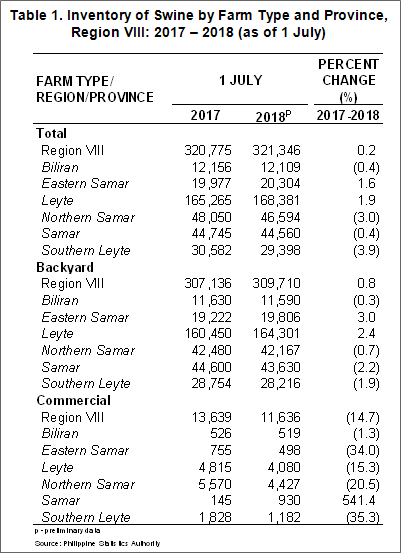Second quarter
swine situationer in Eastern Visayas
By
PSA-8
August 31, 2018
TACLOBAN CITY Ė The
swine industry in Eastern Visayas posted a 9.0% increase in
production during the second quarter of 2018. Based on the
preliminary data, the total swine production in the region went up
to 18,316 metric tons (MT) during the quarter in review from 16,802
MT in the same quarter last year.
Eastern Visayas accounted
for 3.3% of the countryís total swine production during the second
quarter of 2018. It ranked fifth among the regions with low swine
production in the country.
As of 1 July 2018, the
total swine population in Eastern Visayas stood at 321,346 heads.
This registered a slight increase of 0.2% from its 320,775 heads as
of 1 July 2017.
Among provinces, Leyte
recorded the highest number of swine at 168,381 heads, which
comprised more than half or 52.4% of the total swine population in
the region. Northern Samar ranked second with 46,594 heads, which
accounted for 14.5% of the regionís total swine inventory. Biliran,
meanwhile, registered the lowest inventory of swine with 3.8% share
or 12,109 heads.
By farm type, swine
population raised in commercial farms stood at 11,636 heads as of 1
July 2018. This posted a decrease of 14.7% from its 13,639 heads as
of 1 July 2017. All provinces registered decreases, except Samar,
the only province that exhibited an increase of 541.4% to 930 heads
as of 1 July 2018 from 145 heads as of 1 July 2017. Southern Leyte
posted the highest decrease at 35.3%.
On the other hand, the
number of swine raised in backyard farms inched up slightly by 0.8%
to 309,710 heads as of 1 July 2018 from 307,136 heads as of 1 July
2017, where increases registered in Eastern Samar (3.0%) and Leyte
(2.4%) offset the decreases registered in Samar (2.2%), Southern
Leyte (1.9%), Northern Samar (0.7%), and Biliran (0.3%).
Almost all or 96.4% of the
total swine population in the region were raised in backyard farms
while the rest (3.6%) were in commercial farms.
